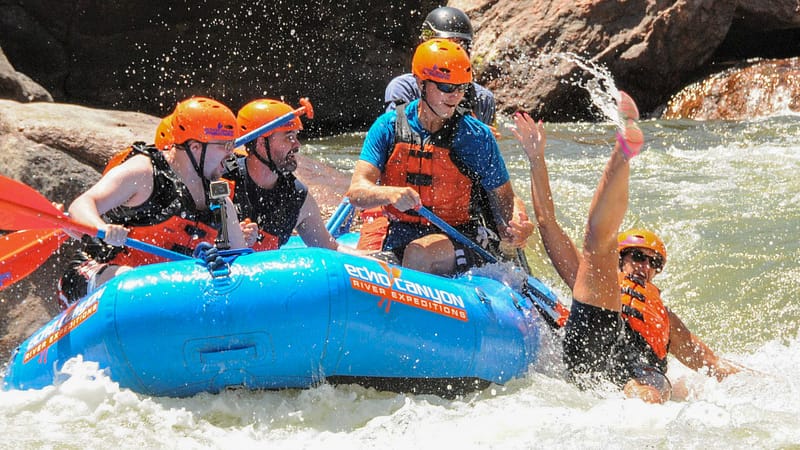While going rafting with a professional outfitter like Echo Canyon is a great way to increase safety on the river, there is always a chance you might fall out of the boat. Thus, knowing how to handle falling out white water rafting before you head out on a trip is essential. This is true whether you are on a family trip or a more advanced rafting trip.
What Are the Essential Steps To Take if You Fall Out of the Raft While White Water Rafting?
White water rafting is a really fun sport and falling in the water is sometimes just part of the package. With professional guides and a bit of training, you should have no problem getting yourself to safety quickly. If you know what to do, falling out white water rafting will result in nothing more than a quick swim and the opportunity to cool down on a hot day! Of course, the goal is to keep you and the rest of the rafting crew onboard the raft. And you may question where are the safest rafting seats to avoid falling out in the first place – for that read our other blog post. BUT, you couls still fall of the raft, so here are some tips to follow if you find yourself overboard.
1. Keep Calm
The most important thing to remember if you fall out of a raft is to keep calm. In fact, panicking in the river will waste your energy, putting you in more danger. Remember, your river guides are professionals and they deal with the types of scenarios nearly every day.
The cardinal rule of swimming in whitewater is to never stand up in the river at any time unless the river is shallower than your arm’s length. If you stand up in deeper water, the current puts you at risk for foot entrapment between rocks, which is an extremely dangerous scenario. Again, staying calm will help you avoid making these types of mistakes.

2. Locate a Raft
Once you pop up out of the water, as calmly as possible assess the situation and locate your raft. It’s likely that the raft will still be next to you. More often than not, a couple of quick swim strokes can get you right back to your raft where another crew member can pull you onboard and to safety.
When you are looking around for your raft, you don’t have to swim to your particular boat. If there are other groups around on the river, simply swim to the closest raft and they will assist you. It’s all about getting to safety as easily as possible.
If there are no rafts nearby and the shoreline is the closest way to get out of the river, then swim to shore. Once you get there, stay put and a guide will come and get you.

3. Assume the White Water Swim Position
 If the water is rough and you are unable to swim to a raft or the shoreline, then it’s best to assume the “white water swim position.” To get in this position, lay on your back with your feet facing downstream. Next, use your arms and hands to maintain this position as you maneuver around waves and rocks.
If the water is rough and you are unable to swim to a raft or the shoreline, then it’s best to assume the “white water swim position.” To get in this position, lay on your back with your feet facing downstream. Next, use your arms and hands to maintain this position as you maneuver around waves and rocks.
If the nearest boat or if shore is far away, you might have to continue in the white water swim position for some time. Always remember to keep your head above water so you can see rocks or waves coming your way, while also focusing on steady breathing. If you come up on a rock that you can’t avoid, simply push off the rock with your feet and legs.
As soon as you get your bearings and the water calms down, roll over and swim to the safety of a boat or the shoreline. Remember, this position is intended to just get you through the roughest water. It’s important to take action as soon as possible and make a move to shore or a raft.
4. Look for a Safety Rope
A safety rope contained in a throw bag is one of the last line of defense for falling out white water rafting. Generally speaking, people are almost always able to quickly self-rescue in a short time by swimming to the raft.
If you are in the water for a long amount of time and can’t make your way to safety without help, a raft guide might throw you a bag filled with rope from the shoreline. As the rope unfurls after being tossed, swim over to it and grab it with both hands against your chest. Next, get into the white water swim position and the rescuer will swing you into shore.
Please note, a safety line is a last-ditch option that is rarely required on a recreational rafting trip. There are other pieces of rafting safety equipment that also help, such as life jackets and helmets, and just your good common sense. That being said, always go with guides who have experience managing rafting emergencies.

Raft the Arkansas River with Echo Canyon!
Ready to experience the thrill of a river trip and learn how to stay safe while white water rafting? At Echo Canyon River Expeditions, our guides are well-trained and put safety first on every rafting trip. Book your next adventure with us and embark on an unforgettable journey through the rapids!
